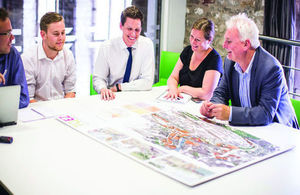Future cities: urban spaces will be ‘radically different’
Dialogue begins about what our cities will look like in 2040, and stresses need for infrastructure design to get smarter.

Some of the UK’s leading thinkers in urban infrastructure came together today to start a conversation about the challenges of supporting a growing population in cities.
The event was part of the Future Cities Dialogue project, by Forum for the Future, Innovate UK, Sciencewise and Ipsos Mori. It coincided with the release of a report which reveals the current trends and challenges in urban development and offers 3 visions for what our cities could look like in 20 years. This is based on substantial dialogue with citizens on the types of cities they would want to live in.
Find out more about our work in infrastructure systems.
Future Cities Dialogue - 3 potential city scenarios
Growing cities
With more than 70% of people estimated to be living in urban areas by 2040, city infrastructure and design is going to need to drastically change in order to better support its citizens.
Speaking at the breakfast session, James Goodman, Director of Futures, Forum for the Future, said:
The year 2040 will be radically different from today. The population in the UK will be 74 million, climate change will have progressed and food production will have needed to increase between 50 and 80%.
In that landscape, the role of cities is critical because it is where ideas are formed and implemented.
Visit Forum for the Future’s project page.
How people are going to live
The group felt that the trajectory of growth in people would place pressure on public and private spaces. The consensus was that infrastructure design will need to get smarter, more collaborative and focus on the needs of people if it is to be effective.
Sophie Thomas, Founding Director of Thomas Matthews and the former Director of Circular Economy for Royal Society of Arts, said:
How are people going to live in these cities? What is the density? That is not going to feel like London and the other cities we know now. Where is all the public space going to go? This is what we really need to be thinking about and what the infrastructure needs to focus on. Where is my 10-year-old going to play football?
Rob Whitehead, Head of Strategy, Future Cities Catapult, added:
The key question is how do we manage the public interest versus the private interest? My optimistic side feels that the promise of what we have ahead of us, is that together we can find better, smarter ways of balancing our interests as a whole in a much more responsive and fine-tuned way then we do now.
Join the discussion
This is only the start of the conversation. Now we want to hear from you. We are hosting a Twitter chat on Wednesday 22 March from 11am to midday to answer any questions about where our urban environments are headed and to gather your thoughts.
Join the Twitter conversation at #citiesdialogue.
Read the Future Cities Dialogue report.